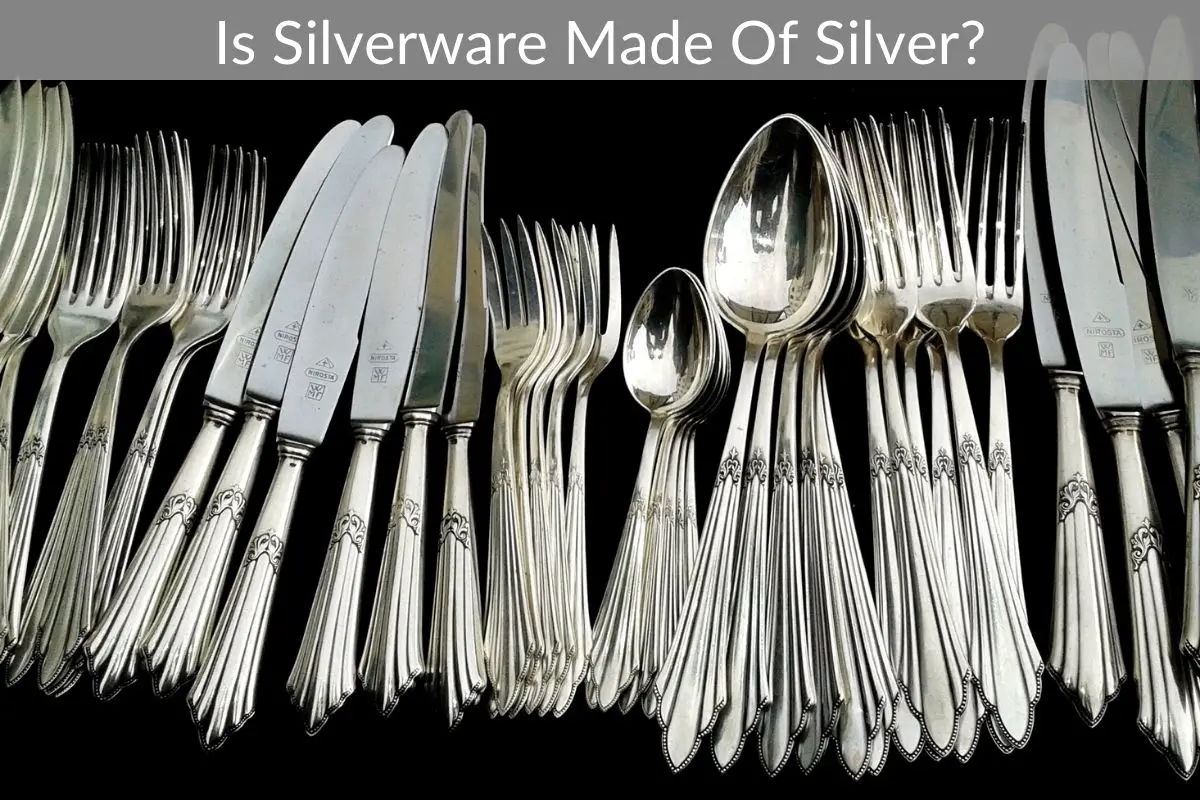Table of Contents
Whenever we are enjoying a delicious meal that requires some type of utensil to eat it with, we use silverware. Silverware comes in many forms: forks, spoons, knives, and there are even different types and styles.
*This post may contain affiliate links. As an Amazon Associate we earn from qualifying purchases.
But what we want to know is, is silverware really made out of silver?
Some silverware is made from real silver, but most of the time, the silverware we eat with at home isn’t. If the silverware is made from real silver, it will be more costly and will be marked with a silver hallmark.
Remember back to your grandmother’s china cabinet? It was organized neatly in rows of fragile table objects. China teapots and dishes decorated every shelf with its delicate material and pretty appearance. Something else that may have been in that china cabin was silverware.
And I don’t mean just regular silverware we use today. But silverware that was made from real silver. All the forks, spoons, and knives were shiny and reflective and just like those special dishes, were only used for special occasions if at all.
Silverware made from real silver is worth as much as the silver that it is made up of. If the piece is made of sterling silver which is 92.5% real silver, then it is worth a decent amount. Though not as much as gold, your silverware will have some value. The price of silver changes from day to day but as of right now, it is worth .8 U.S. dollars per gram.
So, 10 grams of sterling silver is worth $8 and $1000 grams is worth $800.20.
The term silverware has become a generic term and refers to any flatware, dishware, or decorative objects that are made up of a gray metallic material.
Hence its name, silverware used to be made from silver. Silver used to be associated with wealth because silver is expensive and so only the wealthy had these silver utensils at their tables.
Over time, improvements were made as they started electroplating flatware so that it could be available to everyone. Electroplating involves coating a base metal in a silver coating. As silver became more popular and affordable, more were produced in different patterns and types.
Today, silverware made from stainless steel is the most common. There is still silverware that is made from silver but most of the ones we use on an everyday basis are made from stainless steel.
To see some popular silverware sets just click here.
How Can You Tell If Silverware Is Real Silver?
Some pieces of silverware are actually silver-plated instead of being wholly made of silver. This means that they have layered stainless steel with a thin coating of silver on top. Sometimes this coating can be chrome or nickel.
The plating looks like the silverware is real silver, but it has a high resistance to tarnishing, corrosion, and rust. This type of silverware can look beautiful and close to real silverware but it is more affordable.
So, it can be difficult to tell plated flatware from real silverware. So, how can you tell if silverware is real silver?
There are some ways you can find out if silverware is made from real silver. You can check for its hallmark, look at its appearance, or even consult a professional. Real silver can be easy to spot if you know what you are looking for.
Did you know that silver has some sanitation properties? Before modern refrigerators, ancient Phoenecians used silver vessels to keep their water pure. Sailors used to put silver coins in their milk to keep it from spoiling as they went on long journeys. That worked for them since silver has oligodynamic properties and the metal ions in it kill living cells and organisms like mold, fungi, etc.
So, silver can be very useful. Sterling silver is almost completely pure silver. So silverware made from sterling silver is going to be a bit pricey. Let’s take a look at the different ways you can check to see if your grandmother’s silverware is indeed real silver:
- Appearance – If the silverware is an antique then it is going to show some wear. Silver and silver substitutes show age differently. Silver-plated items will start to chip and expose the metal underneath its silver layer, so if you notice any difference in color, look, etc. between its exterior and interior, then this is a sure sign that the silverware isn’t real.
- Buff the silverware – Take an abrasive cloth and buff the silverware, if you notice a black mark, then your piece is most likely real. The black mark can be slight or very noticeable. Real silver reacts with oxygen and forms a tarnish. Silver-plating bonds to the metal it is covering and won’t leave a mark.
- Hallmark – Real silver will have a mark of who made it, its percentage of silver, and sometimes a date. By using a magnifying glass, you can find this imprint. Authentic pictures of silverware will feature a “STER”, “92.5%”, or “925”. These marks mean that it is sterling silver and stands for its percentage of pure silver. If you see any markings of 18/8, 18/10, 18/0, or 13/0, this is a good indication that the silverware is an alloy of stainless-steel alloy plated with a percentage of chromium and nickel. If your silverware was made outside of the U.S. then it will feature some foreign markings.
- Conduct some tests using the magnet test. Silver is not magnetic but other metals are. You can also check the odor. Silver is odorless but if you smell a scent from the piece, it could be silver-plated. Then there is the ice test. Silver has the highest thermal conductivity out of common metals or alloys and will melt the ice quickly. So, if it melts the ice cube faster, then it is most likely made from real silver. Slowy, and it could just be silver-plated.
- Consult a professional – If you have done all of these things and still aren’t sure if the silverware is real silver, you can take it to a jeweler or antique expert. They will know if the pieces are real or not. To find out, they will file down a small area on the piece and then apply nitric acid solution to it. This solution is highly corrosive and can test if the pieces are real or not. If the silverware is real sterling silver, it will turn a creamy white color.
Final Thoughts
Silver used to be what the utensils were made from but this was expensive and over the years, a cheaper way of making silverware was discovered by plating it or making it from other metals entirely.
Some silverware is still made from silver, however, not much is and most of the silverware in everyone’s houses will be made of other metals and not silver.



